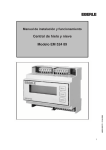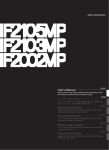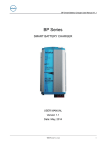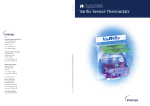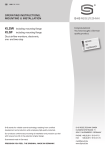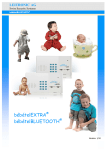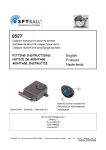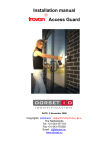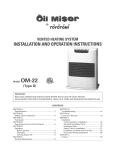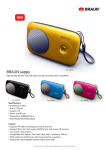Download Assembly and operating instructions Ice detector EM 524 89
Transcript
468 931 003 375 Assembly and operating instructions Ice detector EM 524 89 for open spaces and gutter heating K Contents Application Controls . . . . . . . . . . . . . . . . . . . . . . . . . . . . . . . . . . . . . . . . . . . . . . . . . . . . . . . . . . . . . . . . . . . . . . . . . . . . . . . . . . . . . . . . Page 3 . . . . . . . . . . . . . . . . . . . . . . . . . . . . . . . . . . . . . . . . . . . . . . . . . . . . . . . . . . . . . . . . . . . . . . . . . . . . . . . . . . . . . . . . . . . . Page 3 Menu items . . . . . . . . . . . . . . . . . . . . . . . . . . . . . . . . . . . . . . . . . . . . . . . . . . . . . . . . . . . . . . . . . . . . . . . . . . . . . . . . . . . . . . . . Page Alarm messages Operating Design 6 . . . . . . . . . . . . . . . . . . . . . . . . . . . . . . . . . . . . . . . . . . . . . . . . . . . . . . . . . . . . . . . . . . . . . . . . . . . . . . . . . . Page 8 . . . . . . . . . . . . . . . . . . . . . . . . . . . . . . . . . . . . . . . . . . . . . . . . . . . . . . . . . . . . . . . . . . . . . . . . . . . . . . . . . . . . . . . . . . Page 9 . . . . . . . . . . . . . . . . . . . . . . . . . . . . . . . . . . . . . . . . . . . . . . . . . . . . . . . . . . . . . . . . . . . . . . . . . . . . . . . . . . . . . . . . . . . . . . Page Sensor for open spaces . . . . . . . . . . . . . . . . . . . . . . . . . . . . . . . . . . . . . . . . . . . . . . . . . . . . . . . . . . . . . . . . . . . . . . . . . Page Sensor assembly with sensor housing Sensor for gutters . . . . . . . . . . . . . . . . . . . . . . . . . . . . . . . . . . . . . . . . . . . . . . . . . . . . . . . Page 14 . . . . . . . . . . . . . . . . . . . . . . . . . . . . . . . . . . . . . . . . . . . . . . . . . . . . . . . . . . . . . . . . . . . . . . . . . . . . . . . . Page 18 Setting desired values . . . . . . . . . . . . . . . . . . . . . . . . . . . . . . . . . . . . . . . . . . . . . . . . . . . . . . . . . . . . . . . . . . . . . . . . . . . Page 21 . . . . . . . . . . . . . . . . . . . . . . . . . . . . . . . . . . . . . . . . . . . . . . . . . . . . . . . . . . . . . . . . . . . . . . . . . . . . . . . . Page 22 . . . . . . . . . . . . . . . . . . . . . . . . . . . . . . . . . . . . . . . . . . . . . . . . . . . . . . . . . . . . . . . . . . . . . . . . . . . . . . . . . . . . . . Page 24 Operating modes Maintenance 9 10 Storage program . . . . . . . . . . . . . . . . . . . . . . . . . . . . . . . . . . . . . . . . . . . . . . . . . . . . . . . . . . . . . . . . . . . . . . . . . . . . . . . . . Page Connection diagrams 24 . . . . . . . . . . . . . . . . . . . . . . . . . . . . . . . . . . . . . . . . . . . . . . . . . . . . . . . . . . . . . . . . . . . . . . . . . . . Page 25 . . . . . . . . . . . . . . . . . . . . . . . . . . . . . . . . . . . . . . . . . . . . . . . . . . . . . . . . . . . . . . . . . . . . . . . . . . . . . . . . . . . . Page 29 Appendix: Technical data Quick operating instructions . . . . . . . . . . . . . . . . . . . . . . . . . . . . . . . . . . . . . . . . . . . . . . . . . . . . . . . . . . . . . . . . . . Page 30 WARNING: This electronic device can be fitted independently for the fully automatic electric heating of open spaces, garage drives, stairs, ramps, flat roofs and gutters. The device must only be installed in the housing by a qualified electrician in accordance with the connection diagram. Pay strict attention to the VDE’s and the local electricity supply company’s safety instructions. The device is intended for installation in control cabinets or distributors To achieve protection class II appropriate installation measures must be taken. The device complies with DIN EN 60730 and works in accordance with operating mode 1C. Proper operation is only possible if the system is already put into operation before there is frost or snow and not only when the open spaces or gutters to be heated are already covered with snow or ice. It is recommended that the system is left on during the entire heating period! Note! The system can only work properly if the thermal output of the space to be heated has been calculated properly or adapted to local conditions. Please contact your system installer. 2 Instructions: The ice detector is installed for the fully automatic electric heating of open spaces, garage drives, stairs, ramps, flat roofs and gutters. Unlike manually controlled (touchdependent) or thermostatically controlled (only temperature dependent) systems, the heating will only be switched on if there is a danger of slippery conditions, i.e. snow, ice or sleet and will, naturally, be switched off after thawing. This ensures energy savings of up to 80% compared with thermostatically controlled systems. 106.00 31.50 10.00 45.00 62.00 87.00 90.00 103.00 26.50 48.00 58.00 Controls The ice detector settings can be changed and checked using 3 buttons and a two-line 16-digit display. Button MENU: This button is used to call up the individual menu items. Button VALUE: This button is used to call up the possible settings. Button ENTER: This button is used to store the desired values in the memory. The ice detector has two operating modes which are shown on the display. 1. Measured values mode 2. Menu mode If the ice detector is connected in compliance with the circuit diagram, the voltage is switched on and no button is pressed within 20 seconds, the display will be in “measured values” mode. If a button is pushed the display will change to “Menu” mode. 3 “Measured value” mode = normal operation: The current measured values are displayed in this mode: GROUND/ROOF: From –45 to +78°C (–49 to 172.4 °F) AIR: From –45 to +78°C (–49 to 172.4 °F) MOISTURE: From 0 to 9 HEATING: OFF and ON Note 1* The display changes every three seconds between GROUND/ROOF and AIR values on the one side and MOISTURE and HEATING on the other. For example: GROUND/ROOF: –11°C AIR: –10°C Note 1* or: MOISTURE: 7 HEATING: ON The display changes at three second intervals between GROUND/ROOF and AIR values on the one hand and HUMIDITY and HEATING on the other. If an alarm is on this is also displayed alternately for 3 seconds. Note 1*: The air temperature will only be displayed if the air temperature sensor (available as an optional extra) is also connected (TFD 524 004 on terminals 20 and 21). If no air temperature sensor is connected, then the supplied resistor 82 kΩ (on terminals 20 and 21) must be connected as otherwise the system detects that a sensor has failed. 4 Menu mode In this mode the menu text is displayed in the top line of the menu text and the set value in the bottom line. If you press the top button (MENU) the menu moves on one. If you press the middle button (VALUE) the value of this menu item, shown in the bottom line, is advanced. If you press the bottom button (ENTER), the selected value is stored in the memory. This selection is marked by the word ACTIVE, right-justified in the bottom line. For example: TEMPERATURE + 4°C ACTIVE If no button is pressed within 20 seconds the display changes to “Measured value” mode. When you are using the middle button to advance, the display starts again with the lowest value after the maximum value has been reached. Menu: Default value: Range: Remarks: 2 APPLICATION GROUND GROUND, ROOF RANGE –10 °C (14 °F) –5 °C … –20 °C (23 °F…–4 °F) TEMPERATURE + 3 °C (37.4 °F) 0 °C … 6 °C (32 °F … 42.8 °F) MOISTURE 3 1 … 8 OFF BASE TEMPERATURE OFF –15°C … –1°C , OFF (5 °F … 30.2 °F) POST PURGE 20 MIN 10 MIN …… 20 MIN, OFF OPERATION AUTOMATIC AUTOMATIC, PERMANENT STANDARD PROGRAM ON ON, OFF LANGUAGE GERMAN GERMAN, ENGLISH, FRANCAISE, SUOMI, SVENSKA, CESKY 2 TEMP. UNIT °C °C, °F 2 COUNTER xxxxxHyyM 1 1: This menu item only appears in the GROUND application 2: During the initial installation the default value for the Language menu item is German, for the display menu item, °C, for the application menu item, ground, after which these menu items no longer form part of the default settings. 5 Menu items: Application: Range: GROUND, ROOF default value: GROUND The application (gutter or ground)is selected with this setting. The application selected will be retained when you revert to the default program. Range: Range: –5 … –20 °C (23 …–4 °F) lower temperature limit. default value: –10 °C This temperature value specifies the lower operating temperature limit. Up to this temperature limit the ice detector operates in the normal mode (Heating ON, when the switch on conditions are satisfied). Below this temperature the ice detector will be in “Stand by” mode. Attention: The temperature set here has priority over the set ground temperature. Temperature: Range: 0 … 6 °C (32 … 42.8 °F) Default value: + 3 °C (37.5 °F) If the temperature falls below this set value, the ice detector will switch the heater on if the “moisture” menu item is switched off. If the moisture menu item is set at a certain value the heating system will only be switched on when the temperature falls below this value and the humidity is exceeded. Moisture: Range: 1 to 8, OFF Default value: 3 The sensitivity to humidity is switched on and off here. If it is switched on, you can set a value between 1 (almost dry) and 8 (very damp). Note: If the heating switches off too early, even though conditions are still damp, you can prevent this by adjusting the humidity level to 2. Base temperature: Range: –15 … –1°C (5 … 32.2 °F) Default value: OFF With this setting you can specify a temperature which the temperature of the area to be heated must not fall below. When a temperature is set here, the ice detector will switch the heating on immediately irrespective of the humidity, when the temperature falls below this preset value. This menu item is hidden in the roof application. Attention: The limit temperature set under the “range” menu item area has priority over the set ground temperature. Post purge: Range: 10 MIN to 120 MIN, OFF Default value: 20 MIN You can set a subsequent heating time of between 10 minutes and 2 hours here, in 10 minute increments. This function can also be switched off. Note: If there is still snow or ice remaining when the subsequent heating time has expired, you can prevent this by increasing the subsequent heating time. Bear in mind the increased heating costs should you do this 6 Operation: Range: AUTOMATIC, PERMANENT Default value: AUTOMATIC With this function, you can switch the heating on continuously, irrespective of the set temperatures and humidity. The heating remains switched on during an alarm. Range: ON, OFF Standard program: Default value: ON The ice detector settings can be reset to defined values here. This does not apply to the language, application, display and counter menu items. The set language, application and display are retained and the counter reading can be reset to zero via the appropriate menu item. You can only select ON with this menu item, as the default program is disabled by changing to another menu item. Temp unit: Range: °C, °F Default value: °C Selection of the unit in which temperature values are to be displayed. °C Temperature values displayed in °C. °F: Temperature values displayed in °F. The selected display is retained when you revert to the default program. Language: Range: GERMAN, ENGLISH, FRENCH, FINNISH, SWEDISH, CZECH Various languages can be selected for the ice detector display. German, English, French, Finnish, Swedish and Czech can be selected. The selected language is retained when you revert to the standard program. Counter: 00000H00M to 65535H59M This is the operating hours’ counter for the heating. It is displayed in hours and minutes. The counter reading is retained when you revert back to the default program. To reset the counter, select RESET with the “VALUE” button and then press “ENTER” to reset. The various temperatures are displayed as double-digit values in °C and °F with the correct sign before them. For example: or.: BASE TEMP –10°C TEMPERATURE +3°C The counter reading is displayed in hours and minutes. For example: COUNTER 1 00038H25M This display corresponds to a heating operating time of 38 hours 25 minutes. 7 Alarm messages: In the event of an alarm, the display starts flashing at one second intervals. The alarm relay closing contact (terminals 5 and 6) closes. The word “ALARM” appears on the top line. At the same time, the cause of the alarm is displayed on the bottom line. This alarm display appears in addition to the other displays (measured values) for 3 seconds at a time. The heating relay closing contact (terminals 8 and 9) opens unless continuous heating was selected. Alarm: Fault: Wire colour: Connection: SHORT HEATER Sensor heating humidity sensor Type ESF 524 001/011 or EDS 524 003 Sensor heater short circuit brown/green 14/12 Sensor heating humidity sensor Type ESF 524 001/011 or EDS 524 003 Sensor heater open circuit brown/green 14/12 BROKEN HEATER SHIORT TEMP Temperature sensor Type TFF 524 002/012 or TFD 524 004: brown/yellow or Temperature sensor cut out brown/blue 19/18 BROKEN TEMP Temperature sensor Type TFF 524 002/012 or TFD 524 004: brown/yellow or Temperature sensor cut off brown/blue 19/18 SHORT AIR TEMP Air temperature sensor type TFF 524 004 Temperature sensor short circuit blue/brown 21/20 BROKEN AIR TEMP Air temperature sensor type TFF 524 004 Temperature sensor break SHORT MOISTURE Temperature sensor in moisture sensor Type ESF 524 001/011 or EDS 524 003 Temperature sensor short circuit brown/yellow 14/13 Temperature sensor in moisture sensor Type ESF 524 001/011 or EDS 524 003 Temperature sensor break brown/yellow 14/13 BROKEN MOISTURE blue/brown or R 82 KΩ resistor missing 21/20 Table 2: Alarm messages The settings of the menu items can be changed during an alarm; The display carries on flashing at one-second intervals to display the alarm. The alarm statuses are still displayed up to approximately 5 secs. after fault clearance. When sensor heating is switched on (sensor temperature <4°C) it is permanently monitored for short circuits. It is switched off. for 1 second every 4 minutes to test it for a break. If sensor heating is switched off (sensor temperature > 4°C) it is permanently monitored for a failure. It is switched off for 1 second every 4 minutes to test it for short circuits. 8 Operating: If the temperature set in the ice detector falls below the predetermined value and if the set humidity is exceeded at the same time, the heating will be switched on by means of the HEATER relay and the terminals 8 and 9 (see connection diagram). If one of these conditions is not fulfilled the heating will remain off. The open space or the gutter heating remains switched on until the set humidity falls below a predetermined value or the set temperature is exceeded, If the post purge heating function is needed (generally only if there is still snow remaining on the sides after the heating has been switched off) you can recall this function by pressing the MENU-button and the desired time set. The post purge heating process takes over before the EM 524 89 switches the heating off again, as the temperature or the humidity no longer meet the conditions to be switched on. The lower temperature limit is set (–5°C…–20 °C) in the RANGE menu item The upper temperature limit is fixed at +6°C. Outside this limit the heating can only be switched on using the CONTINUOUS HEAT menu item. The surface of the ice and snow sensors ESF 524 001/011 and ESD 524 003 is heated intermittently to, for example, thaw snow and ice. Water is formed that the sensor will identify as humidity. The BASE TEMP menu item has a setting range of –15°C....–1°C and OFF. This base temperature is, for example, –5 °C and has to keep the surface to be heated from falling below the preset value of –5 °C. If the temperature falls below this preset value, the heating will be switched on until this temperature is exceeded. The lower temperature limit has priority over the base temperature. This means that if the base temperature is set lower than the limit temperature, the base temperature cannot be maintained as the ice detector will be already be in “stand-by” mode. Please take note: The higher the set temperature, the higher the heating costs will be. Design The equipment consists of the central control unit EM 524 89, the separate ice and snow sensor ESF 524 001/011 and the combined temperature and moisture sensor TFF 524 002/012 for open space heating e.g. the ice and snow sensor ESD 524 003 and the temperature sensor TFD 524 004 for gutter heating. Additionally, the TFD 524 004 sensor can be connected as an air temperature sensor and to detect when there is a drop in temperature. Attention The sensors are operated with safety extra low voltage. The appropriate regulations for safety extra low voltage are to be adhered to. In order to ensure trouble-free operation, we recommend that the sensor cables are laid at a sufficient distance from the load circuit and power supply lines. 9 Ice and snow sensor (5-core)ESF 524 001 or ESF 524 011 The sensor is equipped with an NTC resistor to measure the sensor surface temperature, a heating coil and two metal rings as humidity sensors. Nominal voltage: 8V- Power consumption: Approx. 7W Surface temperature: Approx. 4 °C (39.2 °F) Connecting lead: 5 x 0.5 mm; 15 m PVC (5 x 22 gauge x 50 ft.) Ambient temperature: –30 … 80 °C (–22 … 176 °F) Insulating compound: yellow Sensor characteristics – sensor disconnected from EM 524 89 control unit: a) NTC – brown-yellow wires: °C °F –15 5 –10 14 –5 23 0 32 +5 41 +10 50 +15 59 +20 68 +25 77 +30 86 R (K Ohm) 84.5 61.3 47 35.0 27 20.8 16 12.7 10 8.0 b) Heat resistor – brown-green wires: 9 Ω c) Moisture sensors – white-grey wires: ∞ Ω with dry sensor surface Dimensions ESF 524 011 ESF 524 011 ESF 524 011 with FAG 524 111 sensor housing 40 100 Ø 70 Ø 6,3 10 Combined temperature and moisture sensor TFF 524 002 or TFF 524 012 (4 core) The combined sensor is equipped with an NTC resistor for ground temperature measurement and two metal rings are installed as moisture sensors. This sensor is, however, not independently heated. Connecting lead: 4 x 0.5 mm; 15m PVC Ambient temperature: –30 to 80 °C Insulating compound: blue Sensor characteristics – sensor disconnected from EM 524 89 control unit: a) NTC – brown-yellow wires: °C –15 –10 –5 0 +5 +10 +15 +20 +25 +30 R (K Ohm) 11.4 8.9 7.0 5.6 4.5 3.6 2.9 2.4 2.0 1.6 b) moisture sensor – white-grey wires: ∞ Ω with dry sensor surface Dimensions TFF 524 012 TFF 524 012 TFF 524 012 With FAG 524 111 sensor housing 40 100 Ø 70 Ø 6,3 11 Sensor assembly The ice and snow sensor ESF 524 001 (5 core) is assembled as follows. The snow and ice sensor is mounted outside the heated area (see figs. 2 and 3 on page 16). The sensor must be assembled so that it is directly exposed to the weather conditions (snow, rain, melt water (see figs. 4 and 5 on p. 17). The sensor’s steel plate is set in the ground during the construction phase and the wooden mould is placed on top. The steel plate must be used to fix the sensor to guarantee the impermeability of the fixing hole. If the steel plate cannot be inserted due to constructional reasons, then a washer with a nut must be used. This is the only way in which the impermeability (press fit) in the bolt hole can be guaranteed. Note the red information tag! A protective metal pipe must be installed flush to the wooden block for the connection lead. Seal the pipe ends to avoid any foreign bodies (tar, concrete, etc) clogging the protective tube. After applying the top road surface, the wooden mould is removed and the sensor is fixed on the steel plate using the M 6 x 35 screw. Ensure that the sensor cannot, for example, be covered by snow being cleared outside the heated area. Any foreign bodies or materials can impair the operation of the sensor. Any existing gaps must be filled with, for example, silicone, tar, mortar or depending on the composition of the surface. Max. casting temperature 80 °C (179 °F). The sensor’s connection lead, default length 15 m (50 ft.), can, in accordance with VDE 0100, be extended up to a length of 50 m (164 ft.). with a cross section of 1.5mm2 (20 gauge) It is recommended that a numbered cable is used for the extension. This is very helpful, for example, when trying to locate faults during a malfunction. 12 The combined temperature and moisture sensors TFF 524 002 (4 core) are assembled as follows. The combined sensor is installed inside the heated area (see figs. 2 and 3 on page 16) as it must monitor the ground temperature of the heated surface at all times (whether it is switched on or it is switched off). Heating cables must bypass the combined sensor with a minimum distance of 2.5 cm (1“) (see fig. 6 on page 17). Ensure that the heating cables running parallel to one another do not touch. The combined sensor must be fitted so that it is directly exposed to the weather conditions (snow, rain, melt water, etc) (see figs. 4 and 5 on p.17). The combined sensor’s steel plate is embedded in the ground during the construction phase and the wooden mould is placed on top The steel plate must used to fix the sensor to guarantee the impermeability of the fixing hole. If the steel plate cannot be inserted due to constructional reasons, then a washer with a nut must be used. Only in this way can the impermeability (press fit) in the bolt hole be guaranteed. Note the red information tag! A protective metal pipe must be installed flush to the wooden block for the connection lead. Seal the pipe ends to avoid any foreign bodies (tar, concrete, etc) clogging the protective tube. After the applying the top road surface, the wooden block is removed and the sensor is fixed onto the steel plate using a M 6 x 35 screw. Ensure that the combined sensor is fitted so that it is, for example, not covered by snow being cleared outside the heated area and that no vehicles can drive over the combined sensor ( for example, when entering or leaving a garage). Any foreign bodies or materials can impair the operation of the combined sensor. Any existing gaps must be filled with, for example, silicone, tar, mortar or depending on the composition of the surface. Max. casting temperature 80 °C (179 °F). The combined sensor’s connection lead, default length 15 m (50 ft.), can, in accordance with VDE 0100, be extended up to a length of 50 m 164 ft.). with a cross section of 1.5 mm2 (20 gauge). It is recommended that a numbered cable is used for the extension. This is very helpful, for example, when trying to locate faults during a malfunction! 13 Sensor assembly in FAG 524 111 sensor housing Determining where to fit the sensor/sensor housing is extremely important to ensure that the system works as well as it can. The sensor must be fitted where it first becomes smooth or where it is smooth for the longest length. The ESF 524 001/011 sensor (5-core connection cable) is fitted outside the heated surface. The TFF 524 002/012 sensor 4 core connection cable) is fitted inside the heated surface. Installation of the sensor in the FAG 524 111 sensor housing Only the two sensor types ESF 011 and TFF 524 012 are suitable for installation in the sensor housing. With both of these sensors the connecting cable does not come out from the side but from underneath. 40 100 Ø 70 Ø 6,3 14 Installation of the sensor in the FAG 524 111 sensor housing A protective metal pipe running up to the sensor housing should be provided at the construction site for the connection cable. If the sensor is to be run over an appropriate underlay (foundation or base plate) must be provided so that the sensor housing cannot be pushed into the soft ground. Ensure that there is sufficient cable in the lower part of the sensor housing so that, when necessary, the sensor can easily be withdrawn from the housing. Sensor housing in a concrete road surface The sensor housing can be inserted in during the cementing process and the sensor inserted later. Suitable measures must be taken to ensure that the concrete does not get into the housing. The housing is to be installed so that the sensor surface is level with the ground surface. The sensor must not, under any circumstances, project from the ground surface. A level, horizontal installation is fundamental even with a sloping surface. (Please refer to Assembly and operating instructions fig. 5 on page 17). 15 Installation examples: Fig.2 Fig.3 16 Fig.4 Fig.5 Fig.6 17 Ice and snow sensor ESD 524 003 (5-core) The sensor is equipped with an NTC resistor for temperature measurement, a heating coil and two small metal pipes as moisture sensors. Nominal voltage: 8 V- Power consumption: 3W Surface temperature: Approx. 4 °C (39.2 °F) Connecting lead: 5 x 0.25 mm; 4 m PVC (5 x 22 gauge x 13 ft.) Ambient temperature: –30 … 80°C (–22 … 176 °F) Sensor characteristics – sensor disconnected from EM 524 89 control unit: a) NTC – brown-yellow wires: °C °F –16 3 –10 14 –5 21 0 32 +5 43 +10 +15 +20 50 61 68 +25 79 R(K Ohm) 87.2 61.3 48.8 35.0 25.5 20.8 15.4 12.7 9.5 +30 86 +40 104 8.0 5.1 b) Heat resistor – brown-green wires: 20 Ω c) Humidity sensors – white-grey wires: ∞ Ω with dry sensor surface Dimensions 18 107.6 mm (4.24 in.) 30° 10° 10° 20° 164.5 ± 0.5 mm (6.48 in.) 1.5 12.8 mm (0.50 in.) 21.0 mm (0.83 in.) 60.0 mm (2.36 in.) TFD 524 004 (2 core)temperature sensor The temperature sensor is composed of a cable with a compound-filled cap on top and inbuilt NTC resistor. Connecting lead: 2 x 0.5 mm; 4 m PVC (2 x 20 gauge x 13 ft.) Ambient temperature: –30 … 80 °C (–22 … 176 °F) Sensor characteristics – sensor disconnected from EM 524 89 control unit: a) NTC – brown-blue wires: °C °F –15 5 –10 14 –5 23 0 32 +5 41 +10 50 +15 59 +20 68 +25 77 +30 86 R(K Ohm) 11.4 8.9 7.0 5.6 4.5 3.6 2.9 2.4 2.0 1.6 Dimensions 19 Assembly: The ESF 524 003 (5 core)ice and snow sensor is assembled as follows. Where possible, assemble the ice and snow sensor near to the downpipe or waste pipe (lowest point) of the gutter between the heating cables (do not let them come into contact with one another). The sensor is to be fitted so that it lies in the flow direction of the discharged water with the two metal pipes pointing upwards. The water running off is led to the sensor surface by the extruded blower. The blower can be cut to fit the existing conditions of the gutter The sensor’s connection lead, (default length 4 m, 13 ft.), can, in accordance with VDE 0100, be extended up to a length of 50 m (164 ft.). with a cross section of 1.5mm2 (20 gauge) It is recommended that a numbered cable is used when extending the connection lead. This is helpful when trying to locate faults during a malfunction. The temperature sensor ESF 524 004 (2 core) is fitted as follows. The temperature sensor can be fitted outside either on the gutter or near the gutter but whichever one you choose, care must be taken to ensure that the sensor is protected from direct sunlight. The sensor must not be fitted above windows or in areas where heat accumulation can occur (roof sills, chimney, attic windows and the like). The sensor’s connection lead, (default length 4 m, 13 ft.), can, in accordance with the VDE 0100, be extended up to a length of 50 m (164 ft.). with a cross section of 1.5mm2 (20 gauge). It is recommended that a numbered cable is used when extending the connection lead. This is helpful when locating faults during a malfunction. Temperature sensor TFD 524 (2-strand) fixed at gutter Installation instruction: fixing material must be supplied by others, depending on the gutter in each individual case! Clamp (Not contained in scope of supply) Clamp (Not contained in scope of supply) Ice and snow sensor ESD 524 003 (5-strand) Heating lead 20 Gutter Setting desired values Range setting The RANGE menu item is called up with the MENU button and the lowest temperature limit is set with the VALUE button. This temperature value specifies the lower operating temperature limit. The upper working temperature is fixed at +6 °C (42.8 °F). Up to this temperature limit the ice detector operates in normal mode (Heating ON, when the conditions for switching it on are satisfied). Below this temperature the ice detector will be in “Stand by” mode. Attention: The temperature range set here has priority over the base temperature. Temperature setting The TEMPERATURE menu item is called up with the MENU button and the desired temperature set with the VALUE button and the value is saved by pressing ENTER. An optimum temperature setting is +3 °C (37 °F). Moisture setting: The MOISTURE menu item is called up with the MENU button and the desired setting selected with the VALUE button. The value is saved by pressing ENTER. An optimum moisture setting is 5. If there is a greater danger of pollution a setting of 6 or 7 must be made. If the heating switches off too early, even though conditions are still humid, you can prevent this by adjusting the moisture value to 3 or 2. Base temperature setting The BASE TEMP menu item is called up with the MENU button and the desired setting selected with the VALUE button. The value is saved by pressing ENTER. We recommend a setting of –5 °C. The higher the set temperature, the higher the heating costs will be. This menu item is hidden in the roof application. Please ensure that the ground temperature set value is not lower than the lowest ground temperature value set. 21 Operating modes 1. Default settings: Menu Value Remarks: APPLICATION GROUND 2 RANGE –10 °C TEMPERATURE +3 °C MOISTURE 3 BASE TEMP OFF POST PURGE 20 minutes OPERATION AUTOMATIC STANDARD PROGRAM ON TEMP UNIT °C 2 LANGUAGE GERMAN 2 2: During the initial installation the default value for the Language menu item is German, for the display menu item, °C, for the application menu item, Ground, after which these menu items no longer form part of the default settings. In the default settings (standard program) the heating will be controlled by a combination of temperature and humidity. The heating is switched on when the temperature falls below 3 °C (37.5 °F) and the humidity exceeds 3. If the temperature falls below 3 °C (37.5 °F) the set post purge time will be switched on. The heating will be switched off once the post purge time has expired. If the humidity of 3 is exceeded the set post purge time will turn on and the heating will be switched off once this time has elapsed. 2. Normal base temperature operation Menu Value BASE TEMP –5 °C (23 °F) The BASE TEMP menu item is set at –5°C (23 °F), the rest of the settings are as in point 1. The operation is as described in point 1. An added factor is that with a temperature beneath –5 °C the heating will be switched on regardless of the humidity and will stay switched on until the temperature goes above –5 °C (23 °F). If the subsequent heating time is set the heating will stay switched on till the time has elapsed. 22 3. Manual operation Menu Value OPERATION PERMANENT The heating is switched on immediately and can only be switched off using this menu item. With manual operation the heating remains switched on even during alarms. 4. Operating without moisture influence Menu Value TEMPERATURE +3 °C (37.5°F) MOISTURE OFF If the MOISTURE menu item is set to OFF the ice detector will thermostatically control the heating. If the set temperature falls below the preset value the heating will be switched on and if exceeded the heating will be switched off depending on the post purge time. 5. Monitoring the heated area when there is a drop in temperature This function is only possible when the air temperature sensor TFD 524 004 is connected (see connection diagram EM 524 89 Using open space heating). If there is a sudden several degree drop in temperature and it drops below 7 °C (45 °F) then the heating is switched on as a precaution for 1 hour as it is highly likely that it will rain and the temperature will decrease. Depending on the set temperature and humidity the heating will stay switched on or will switch off after 1 hour. This sensor must be installed as well as the default sensors (Ice and snow sensor ESF 524 001/011 and combined temperature and humidity sensor TFF 524 022/012). They should be fitted in a covered area approx. 2–3 m above ground level. The sensor connection is shown in the connection diagram. Attention: The air temperature sensor must not be fitted over doors, windows or next to lights or spotlights. 23 Maintenance Ensure that the surfaces of the ESF 524 001/011, TFF 524 002/012 and ESD 524 003 sensors are kept clean at all times. A regular inspection of the control unit is recommended so that any alarm messages can be recognised and rectified in a timely fashion. Only then will it be possible for the system to operate flawlessly. Storage program Order no. Ice detector control unit EM 524 89 0524 89 144 100 Sensor for open space heating: Ice and snow sensor ESF 524 001 0524 99 000 001 (cable outlet on the side) 15m connection lead Ice and snow sensor ESF 524 011 0524 99 000 011 (cable outlet underneath) 15 m connection lead Combined temperatureand humidity sensor TFF 524 002 0524 99 000 002 (cable outlet on the side) 15 m connection lead Combined temperatureand humidity sensor TFF 524 012 0524 99 000 012 (cable outlet underneath) 15 m connection lead Sensor housing (can only be used with ESF 524 011 and TFF 524 012 sensors) FAG 524 111 0524 99 000 111 Ice and snow sensor ESD 524 003 4 m connection lead 0524 99 000 003 Temperature sensor TFD 524 004 4 m connection lead 0524 99 000 004 Sensor for gutter heating: 24 Connection diagram for EM 524 89 Connection diagram 1: Ice detector connection with ESF 524 001/011 and TFF 524 002/012 sensors for open space heating. Combined temperature and humidity sensor TFF 524 002 / 012 Ice and snow sensor ESF 524 001 / 011 82 K* gr gn ge ws br X2 10 11 12 13 14 15 10 11 12 13 14 ws gn ge/ye br gr 15 gr ge br 16 17 18 19 20 21 X3 16 17 ws 18 gr 19 20 21 br bl ge/ye br 524 002 / 012 524 001 / 011 / 003 524 004 bl 230 V Legend: ws weiß/white gn grün / green br braun / brown gr grau / grey ge gelb / yellow bl blau / blue br NC 1 2 X1 1 2 3 3 R = 82K Optional temperature sensor TFD 524 004 HEATER 230 V / 16 A NC 4 5 4 6 5 ALARMUnit 82K* or 82K ALARM 230 V / 2 A ~ -20 T 50 524 004 7 6 8 9 7 8 9 Heating ws L1 230 V AC N 20 21 PE Note: Instead of the default 82 kΩ resistor a separate TFD 524 004 temperature sensor can be installed. This sensor is used to detect a drop in temperature and the air temperature thus measured is shown on the display. 25 Connection diagram 2: Ice detector connection with ESD 524 003 and TFD 524 004 sensors for gutter heating. Ice and snow sensor ESD 524 003 Temperature sensor TFD 524 004 82 K* gr gn ge br bl X2 10 11 12 13 14 15 10 11 12 13 14 ws gn ge/ye be gr 15 br 16 17 18 19 20 21 X3 16 17 ws 18 gr 19 20 21 br bl ge/ye br 524 002 / 012 524 001 / 011 / 003 524 004 bl 230 V Legend: ws weiß/white gn grün / green br braun / brown gr grau / grey ge gelb / yellow bl blau / blue br NC 1 2 X1 1 2 3 3 R = 82K Optional temperature sensor TFD 524 004 HEATER 230 V / 16 A NC 4 5 4 6 5 ALARMUnit 82K* or 82K ALARM 230 V / 2 A ~ -20 T 50 524 004 7 6 8 9 7 8 9 Heating ws L1 230 V AC N 20 21 PE Note: Instead of the default 82 kΩ resistor a separate TFD 524004 temperature sensor can be installed. This sensor is used to detect a drop in temperature and the air temperature thus measured is shown on the display. 26 Connection diagram 3: Ice detector connection with ESF 524 001 and TFD 524 004 sensors. Open space without second humidity measuring point (max. open space. 5m2). Ice and snow sensor ESF 524 001 / 011 Temperature sensor TFD 524 004 82 K* gr gn ge br bl br X2 10 11 12 13 14 15 10 11 12 13 14 ws gn ge/ye br gr 15 16 17 18 19 20 21 X3 16 17 ws 18 gr 19 20 21 br bl ge/ye br 524 002 / 012 524 001 / 011 / 003 524 004 bl Legend: ws weiß/white gn grün / green br braun / brown gr grau / grey ge gelb / yellow bl blau / blue br ~ NC 1 2 X1 1 2 3 3 R = 82K Optional temperature sensor TFD 524 004 HEATER 230 V / 16 A NC 4 5 4 6 5 ALARMUnit 82K* or 82K ALARM 230 V / 2 A 230 V -20 T 50 524 004 7 6 8 9 7 8 9 Heating ws L1 230 V AC N 20 21 PE 27 Technical data Type EM 524 89 EDV no. 0524 89 144 100 Operating voltage: AC 230 V ±10 %, 50/60 Hz Power consumption: ≤ 15 VA Ambient temperature: –20 … + 50 °C (–4 … 122 °F) Storage temperature: –20 … + 70 °C (–4 … 158 °F) Desired value range Range: Lower temperature limit –5 ... –20 °C (3 … –4 °F) Temperature: 0 °C … +6 °C Base temperature: –15 … –1°C (5 … 30 °F) and Off Moisture: 1 (sensitive)… 8 (insensitive) and Off Post purge: 10 min 120 min and Off Operation: Automatic and Permanent Language: German, English, French, Finnish, Swedish and Czech. Outputs Heater On/Off: Relays, 1 closing contact Switching capacity: AC 250 V, 16 A cos ϕ= 1; 4 A cosϕ = 0.6 Alarm On/Off: Relays, 1 c/o contact Switching capacity: AC 250 V, 2 A cosϕ = 1; 0.8 A cosϕ = 0.6 Inputs Ice and snow sensor: Type ESF 524 001/011 for open spaces Type ESD 524 003 for gutters Ground temperature sensor: TFF 524 002/012 type for open spaces TFD 524 004 type for gutters Air temperature sensor: 28 Type TFD 524 004 Display* LCD Display: 2-row 16-digit Temperatures: –45 … + 78 °C (–49 … 172 °F) Humidity: 0…9 Heating: ON, OFF Fault status: Fault sensor Parameters: Values and selection *) below 0°C (32 °F) the correct reading of the LCD display cannot be guaranteed, the operation of the equipment, however, will not be affected by this. Controls Input buttons: 3 Piece (MENU / VALUE / ENTER) General details Complies with: DIN EN 60 730 T. 1 and T. 2-9 -12.2005 Protection class: II is achieved by observing appropriate installation measures Protection type: IP 20 EN 60 529 Shockproof: in accordance with VBG 4 Nominal insulation voltage: 250 V Assembly Snap-on mount on DIN EN 50022-35 Standard rail Housing dimensions 106 x 90 x 58 mm (45 cut out) Housing material: PC; UL94-V0 Weight: Without sensor and packaging approx. 480 g Brief operating instructions for ice detector EM 524 89 for open space and gutter heating Application: The ice detector is used for the fully automatic electric heating of open spaces, garage drives, stairs, ramps, flat roofs and gutters. Unlike manually-controlled (touch dependent) or thermostatically-controlled (temperature dependent only) systems, the heating will only be switched on if there is a danger of slippery conditions such as snow, ice or sleet and will, naturally, be switched off after thawing. This ensures energy savings of up to 8 0 % compared with thermostatically-controlled systems. Operation: For problem free operation a default program is saved. The ice detector works on the basis of this default program after installation. These settings can be recalled at any time using the STANDARD PROGRAM menu item. Default program: Menu: Default value: Range: Remarks: 2 APPLICATION GROUND GROUND, ROOF RANGE –10°C (14 °F) –5 … –20°C (23 … –4 °F) TEMPERATURE +3 °C (37.4 °F) 0 … 6 °C (32 … 43 °F) MOISTURE 3 1 – 8, OUT BASE TEMPERATURE POST PURGE OFF 20 MIN …15 … –1 °C (5 … 30 °F), OFF 10 MIN … 120 MIN OFF STANDARD AUTOMATIC AUTOMATIC, PERMANENT DEFAULT PROGRAM ON ON, OFF TEMP UNIT LANGUAGE °C GERMAN °C, °F GERMAN, ENGLISH, FRENCH, FINNISH, SWEDISH, CZECH COUNTER xxxxxHyyM 1 2 2 1: These menu items only appear in the GROUND application 2: During the initial installation the default value for the Language menu item is German, for the display menu item, °C, for the application menu item, ground, after which these menu items no longer form part of the default settings. Use the MENU button to select all of the menu items in order. The selected menu item is shown in the top display line. The bottom display line shows the current value for this menu item and “ACTIVE”. For example: TEMPERATURE 3 °C ACTIVE The desired value can be changed with the VALUE button. When the highest desired value is reached and the button is pushed again it will start at the lowest value again. The current desired value is marked with the word ACTIVE. If another value is selected only this will be in the bottom line. According to the above example after pressing the VALUE button 4 times the display would be: TEMPERATURE 0°C If this value is now to be applied press ENTER. The new value will be applied to the control program and displayed with the word ACTIVE. The display is now: TEMPERATURE 0°C ACTIVE If you do not press ENTER or if after you have selected the new desired value with the VALUE button another menu item is selected with the MENU button, the new value will not be applied. If no button is pushed for 10 seconds the display changes to ”Measured value“ mode. The mode changes between display of the measured temperatures on the one hand and the humidity and the heating on the other at 3 second intervals. If the supplied resistor is connected instead of the air temperature sensor, the value for the air temperature is not shown. For example: GROUND –11°C AIR –11°C and HUMIDITY 7 HEATING ON Should there be an alarm, the display starts flashing at one second intervals. The alarm relay closing contact (terminals 5 and 6) closes. The word “ALARM“ appears on the top line. At the same time, the cause of the alarm is displayed on the bottom line. The measured values continue to be displayed: For example: ALARM TEMP SHORT CIRCUIT Here the display again changes to menu mode when the button is pushed only this time the display flashes to continue drawing attention to the alarm. During an alarm the menu items can be selected, for example, leaving the heating system switched on in manual mode. If no button is pushed for 20 seconds the alarm will be displayed again. 31 K EBERLE Controls Gmbh Postfach 13 01 53 D-90113 Nürnberg Klingenhofstrasse 71 D-90411 Nürnberg/Germany Telephone 09 11 / 56 93-0 and fax 09 11 / 56 93-536 Errors and omissions excepted.

































